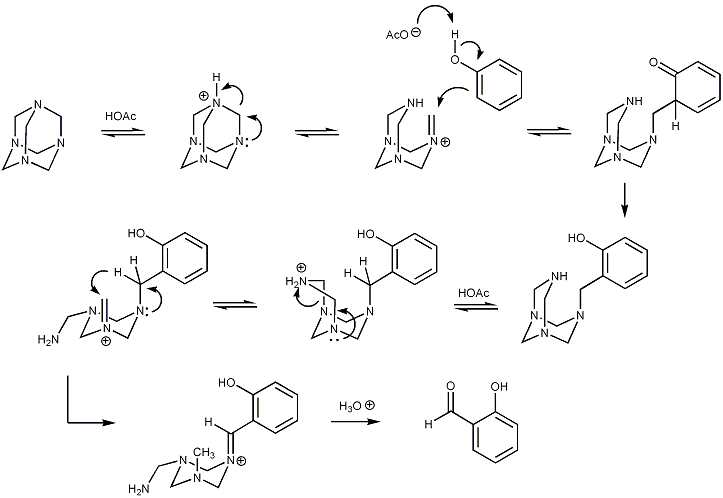Chemistry:Duff reaction
The Duff reaction or hexamine aromatic formylation is a formylation reaction used in organic chemistry for the synthesis of benzaldehydes with hexamine as the formyl carbon source. The method is generally inefficient.[1] The reaction is named after James Cooper Duff.[2] The reaction requires strongly electron donating substituents on the aromatic ring such as in a phenol. Formylation occurs ortho to the electron donating substituent preferentially, unless the ortho positions are blocked, in which case the formylation occurs at the para position.[3]
Examples
The modified salicylaldehyde 3,5-di-tert-butylsalicylaldehyde is prepared by the Duff reaction:[4]
The natural product syringaldehyde can also be prepared by the Duff reaction. In this example, formylation occurs at the position para to the phenolic OH.[5]
Unlike other formylation reactions the Duff reaction is able to attach multiple aldehyde groups. If both ortho positions are vacant then a diformylation is possible, as in the formation of diformylcresol from p-cresol.[6] Conversion of phenol to the corresponding 1,3,5-trialdehyde has also been reported[7]
Reaction mechanism
The reaction mechanism is related to that for the Reimer–Tiemann reaction, which uses chloroform as the formylating agent.[1] Protonated hexamine ring-opens to expose an iminium group. Addition to the aromatic ring results in an intermediate at the oxidation state of a benzylamine. An intramolecular redox reaction then ensues, raising the benzylic carbon to the oxidation state of an aldehyde. The oxygen atom is provided by water on acid hydrolysis in the final step.
Historical references
Duff was a chemist at the College of Technology, Birmingham, around 1920–1950.[2] who
- Duff, J. C.; Bills, E. J. (1934). "282. Reactions between hexamethylenetetramine and phenolic compounds. Part II. Formation of phenolic aldehydes. Distinctive behaviour of p-nitrophenol". J. Chem. Soc.: 1305. doi:10.1039/jr9340001305.
- Duff, J. C.; Bills, E. J. (1941). "96. A new general method for the preparation of o-hydroxyaldehydes from phenols and hexamethylenetetramine". J. Chem. Soc.: 547. doi:10.1039/jr9410000547.
- Duff, J. C.; Bills, E. J. (1945). "71. A new method for the preparation of p-dialkylaminobenzaldehydes". J. Chem. Soc.: 276. doi:10.1039/jr9450000276.
- Lloyd Noel Ferguson (1946). "The Synthesis of Aromatic Aldehydes". Chem. Rev. 38 (2): 227–254. doi:10.1021/cr60120a002. PMID 21024865.
- Ogata, Y.; Sugiura, F. (1968). "Kinetics and mechanism of the Duff reaction". Tetrahedron 24 (14): 5001. doi:10.1016/S0040-4020(01)88408-8.
See also
- Bouveault aldehyde synthesis
- Bodroux-Chichibabin aldehyde synthesis
- Reimer-Tiemann reaction
- Sommelet reaction
- Vilsmeier-Haack reaction
References
- ↑ 1.0 1.1 March, Jerry (1985), Advanced Organic Chemistry: Reactions, Mechanisms, and Structure (3rd ed.), New York: Wiley, p. 727, ISBN 0-471-85472-7
- ↑ 2.0 2.1 Duff, J. C.; Bills, E. J. (1932). "273. Reactions between hexamethylenetetramine and phenolic compounds. Part I. A new method for the preparation of 3- and 5-aldehydosalicylic acids". J. Chem. Soc.: 1987. doi:10.1039/jr9320001987.
- ↑ Mundy, Bradford P.; Ellerd, Michael G.; Favaloro, Frank G. (2005). Name Reactions and Reagents in Organic Synthesis, 2nd Edition, John Wiley & Sons, pp. 222 – 223.
- ↑ Larrow, Jay F.; Jacobsen, Eric N. (1998). "(R,R)-N,N'-Bis(3,5-di-tert-butylsalicylaldehyde)-1,2-cyclohexanediamino Manganese(III) Chloride, a Highly Enantioselective Epoxidation Catalyst". Organic Syntheses 75: 1. doi:10.15227/orgsyn.075.0001. http://www.orgsyn.org/demo.aspx?prep=v75p0001.; Collective Volume, 10, pp. 96
- ↑ Allen, C. F. H.; Leubner, Gerhard W. (1951). "Syringic aldehyde". Organic Syntheses 31: 92. doi:10.15227/orgsyn.031.0092. http://www.orgsyn.org/demo.aspx?prep=cv4p0866.; Collective Volume, 4, pp. 866
- ↑ Lindoy, Leonard F. (July 1998). "Mono- and Diformylation of 4-Substituted Phenols: A New Application of the Duff Reaction". Synthesis 1998 (7): 1029–1032. doi:10.1055/s-1998-2110.
- ↑ Anderson, Andrew A.; Goetzen, Thomas; Shackelford, Scott A.; Tsank, Stella (September 2000). "A Convenient One-Step Synthesis of 2-Hydroxy-1,3,5-Benzenetricarbaldehyde". Synthetic Communications 30 (17): 3227–3232. doi:10.1080/00397910008086933.
 |




